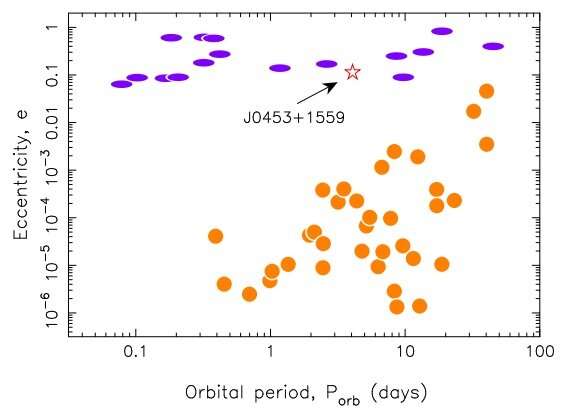October 7, 2019 report
PSR J0453+1559 may be a neutron star–white dwarf binary, study suggests

Astronomers have investigated a compact binary radio pulsar system known as PSR J0453+1559, with the aim of shedding more light on its mysterious nature. The new study, published September 26 on arXiv.org, challenges previous assumptions, suggesting that system contains a white dwarf companion.
Pulsars are highly magnetized rotating neutron stars that emit beams of electromagnetic radiation, from radio to X-ray and gamma-ray frequencies. Many pulsars are formed in binary systems when the initially more massive component turns into a neutron star that is then spun-up due to accretion of matter from the secondary star.
Discovered in 2015, PSR J0453+1559 is a pulsar with a spin period of 45 ms, mildly recycled by the accretion of matter from the progenitor of the companion star. The mass of the primary star is approximately 1.56 solar masses, while the mass of the unseen companion was inferred to be around 1.17 solar masses. The two components orbit each other on a 4.07-day orbit with an eccentricity of 0.11.
Previous studies classified PSR J0453+1559 as a double neutron star system, given that its orbital eccentricity is typical for other known systems of this type so far identified in the Milky Way's disk. However, a new study co-authored by Thomas Tauris of Aarhus University in Denmark and Hans-Thomas Janka of Max Planck Institute for Astrophysics in Germany, proposes a different hypothesis for the nature of the companion, pointing out the relatively low mass of this object.
"Because of the relatively large orbital eccentricity of e = 0.1125, it was argued that the companion is a neutron star, making it the neutron star with the lowest accurately determined mass to date. However, current state-of-the-art stellar evolution and supernova modeling have difficulties to produce such a low-mass neutron star remnant," the astronomers wrote in the paper.
The researchers say that current supernova explosion simulations do not support the possibility of neutron star formation with masses below 1.2 solar masses. Therefore, the authors of the paper ponder other possibility that could explain the nature of the less massive component.
According to Tauris and Janka, the unseen object could be a white dwarf formed as a result of a thermonuclear electron-capture supernova (tECSN) event. TECSNe are incomplete explosions of degenerate oxygen-neon-magnesium cores by oxygen deflagration, leaving behind white dwarf remnants.
"The lower-mass component could instead be a white dwarf born in a thermonuclear electron-capture supernova (tECSN) event, in which oxygen-neon deflagration in the degenerate stellar core of an ultra-stripped progenitor ejects several 0.1 solar masses of matter and leaves a bound ONeFe white dwarf as the second-formed compact remnant," the paper reads.
The astronomers noted that in the case of PSR J0453+1559, such a progenitor would most likely be around 50 percent more massive than our sun in order to produce a white dwarf with an estimated mass of approximately 1.17 solar masses. They added that the system would have an orbital period of about three days before the supernova explosion.
Moreover, the scientists calculated that a remnant kick of above 69 km/s is needed to explain the properties of PSR J0453+1559 as a neutron star-white dwarf system.
In general, the researchers say that still more studies are needed to assess the viability of their scenario. However, they noted that their research shows that the double neutron star should not be perceived as the most plausible hypothesis.
More information: J0453+1559: a neutron star-white dwarf binary from a thermonuclear electron-capture supernova? arXiv:1909.12318 [astro-ph.SR] arxiv.org/abs/1909.12318
Provided by Science X Network
© 2019 Science X Network




















